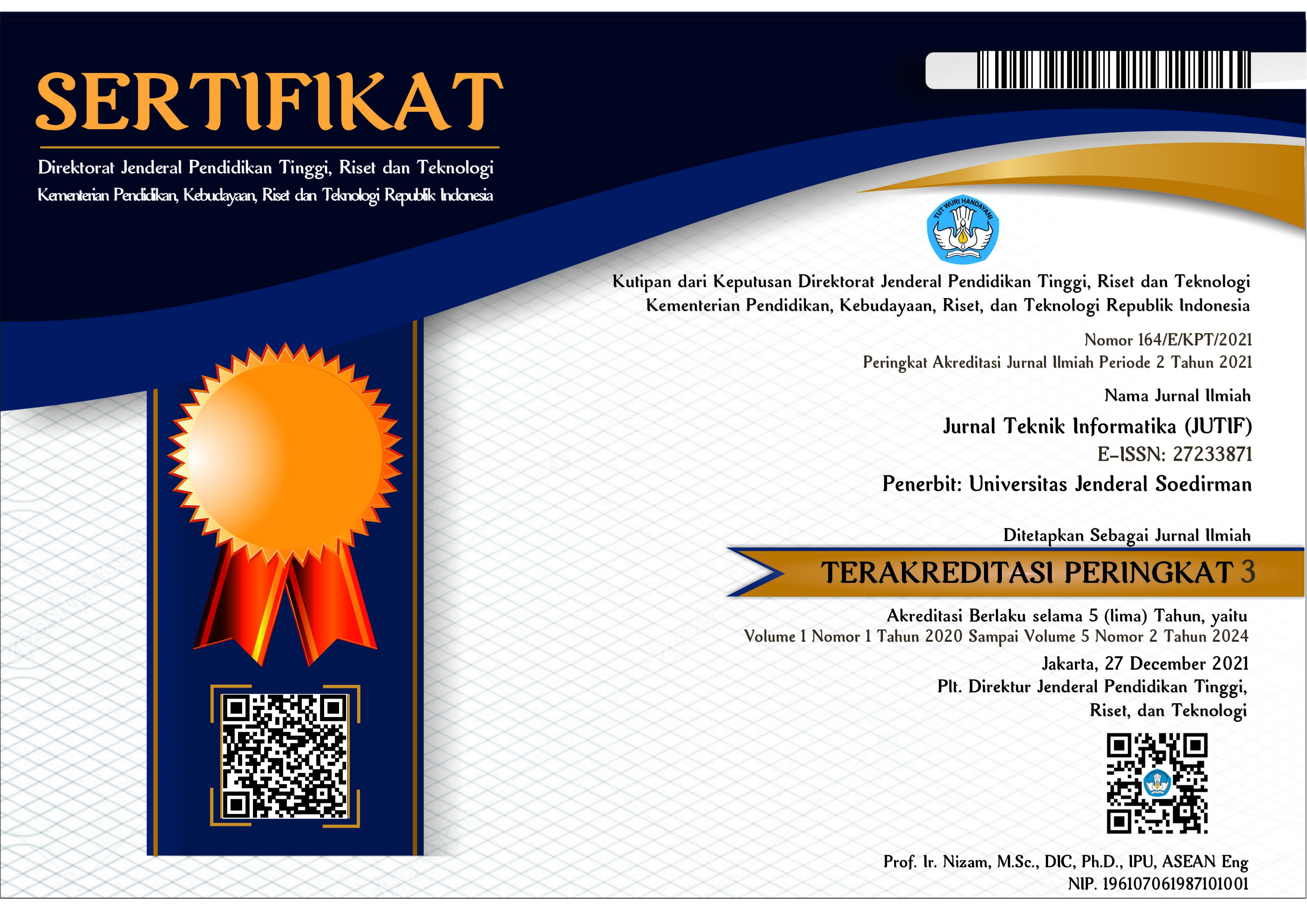OPTIMIZATION OF MARKET BASKET ANALYSIS USING CENTROID-BASED CLUSTERING ALGORITHM AND FP-GROWTH ALGORITHM
DOI:
https://doi.org/10.20884/1.jutif.2022.3.6.399Keywords:
centroid-based algorithm, clustering, FP-Growth, lift ratio, market basket analysisAbstract
The proliferation of the food and beverage sales business requires the creativity of business owners to offer their flagship products to every consumer, both new and subscribed consumers. A large number of menu choices makes the ordering process long because consumers are confused about which menu will be the best choice. the seller to be able to provide the right recommendations so that orders can take place faster. Shopping cart analysis is an activity that has often been done to find out the items found that are sold simultaneously. The FP-Growth association method is a faster algorithm for generating association rules, but the association process in large dataset sizes tends to add large items so that the accuracy value of association rules decreases. So that in this study, the grouping of datasets was carried out using a clustering model with a centroid-based algorithm, namely k-means, k-medoids, and fuzzy c-means. This research was conducted through dataset collection, dataset preparation, clustering modeling, evaluation of clustering models using DBI and silhouette index, association modeling, and evaluation of association models using lift ratio. The results of this study showed that the clustering model with the best DBI and silhouette index values was at k=3 for k-means, k=2 for k-medoids, and k=7 for fuzzy c-means. The number of association rules is generated from the grouped data set using fuzzy c-means, but the highest average lift ratio is in the association rules generated from the grouping data set using k-means. From the association model using k-means and FP-Growth, 32 unique association rules were found with the 4 most frequently found items, namely cireng chili oil, regal milk coffee, banana cheese, and vietnam drip.
Downloads
References
S. Rijal, M. I. S. Ahmad, N. Arisah, Nurdiana, and M. Hasan, “Kajian Peluang dan Tantangan UMKM: Sanggupkah Sektor Kuliner Bertahan di Masa Pandemi COVID-19,” Proceeding Teknol. Pendidik. Semin. Daring Nas. 2021 Digit. Gener. Digit. Nation, pp. 115–1225, 2021.
Taufikurrahman, “Analisis penjualan online ditengah pandemi covid-19 Analysis of online sales in the midst of the covid-19 pandemic,” J. Ekon. dan Manaj., vol. 18, no. 3, pp. 440–445, 2021.
S. N. Rohmah, “Adakah peluang bisnis di tengah kelesuan perekonomian akibat pandemi Corona virus Covid-19 ?,” ’ADALAH Bul. Huk. Keadilan, vol. 4, no. 1, pp. 63–74, 2020.
D. Rusdianto, Sutiyono, and L. Zaelani, “Implementasi Data Mining Menggunakan Algoritma Apriori Untuk Mengetahui Pola Peminjaman Buku Di Perpustakaan Universitas Bale Bandung,” J-Sika, vol. 02, no. 02, pp. 1–10, 2020, [Online]. Available: https://ejournal.unibba.ac.id/index.php/j-sika/article/view/376/313.
K. N. Wijaya, R. F. Malik, and S. Nurmaini, “Analisa Pola Frekuensi Keranjang Belanja Dengan Dengan Perbandingan Algoritma Fp-Growth (Frequent Pattern Growth) dan Eclat pada minimarket,” JATISI (Jurnal Tek. Inform. dan Sist. Informasi), vol. 7, no. 2, pp. 364–373, 2020, doi: 10.35957/jatisi.v7i2.380.
L. Indah Prahartiwi, S. Informasi, S. Nusa Mandiri, J. Damai No, and W. Jati Barat Jakarta Selatan DKI Jakarta, “Pencarian Frequent Itemset pada Analisis Keranjang Belanja Menggunakan Algoritma FP-Growth,” Inf. Syst. Educ. Prof., vol. 2, no. 1, pp. 1–10, 2017.
R. Sari and R. Y. Hayuningtyas, “Analisis Keranjang Belanja Pada Transaksi Penjualan Menggunakan Algoritma Apriori,” EVOLUSI J. Sains dan Manaj., vol. 9, no. 1, pp. 46–51, 2021, doi: 10.31294/evolusi.v9i1.9999.
N. R. S. Purba and F. Riandari, “Implementasi Data Mining Menggunakan Algoritma Apriori Untuk Analisis Keranjang Belanja Pada Transaksi Penjualan Pada PT Madu Kembang Joyo,” J. Nas. Komputasi dan Teknol. Inf., vol. 4, no. 1, pp. 69–74, 2021, doi: 10.32672/jnkti.v4i1.2745.
M. S. B. Butar and E. Elisa, “RULES ASSOCIATION FP-GROWTH DALAM ANALISIS KERANJANG PASAR,” Comasie, vol. 6, no. 2, pp. 127–136, 2022.
D. Cahyanti and I. Permana, “Comparison of Book Shopping Patterns Before and During the Covid-19 Pandemic Using the Fp-Growth Algorithm At Zanafa Perbandingan Pola Belanja Buku Sebelum Dan Masa Pandemi Covid-19 Menggunakan Algoritma Fp-Growth Pada Toko Buku,” J. Tek. Inform., vol. 3, no. 2, pp. 381–386, 2022.
S. Wahyuni, Suherman, and lumalo portibi Harahap, “Implementasi Data Mining dalam Memprediksi Stok Barang Menggunakan Algoritma Apriori,” J. Tek. DAN Inform., vol. 5, no. 2, pp. 67–71, 2018.
M. I. Ghozali, R. Z. Ehwan, and W. H. Sugiharto, “Analisa Pola Belanja Menggunakan Algoritma Fp Growth, Self Organizing Map (Som) Dan K Medoids,” Simetris J. Tek. Mesin, Elektro dan Ilmu Komput., vol. 8, no. 1, pp. 317–326, 2017, doi: 10.24176/simet.v8i1.995.
X. Wu et al., “Top 10 algorithms in data mining,” Knowl. Inf. Syst., vol. 14, no. 1, pp. 1–37, 2008, doi: 10.1007/s10115-007-0114-2.
I. Syukra, A. Hidayat, and M. Z. Fauzi, “Implementation of K-Medoids and FP-Growth Algorithms for Grouping and Product Offering Recommendations,” Indones. J. Artif. Intell. Data Min., vol. 2, no. 2, p. 107, 2019, doi: 10.24014/ijaidm.v2i2.8326.
N. Mamahit and A. Qoiriah, “Penerapan Algoritma Fp-Growth dan K-Means pada Data Transaksi Minimarket,” J. Informatics Comput. Sci., vol. 1, no. 02, pp. 78–83, 2019.
N. P. Dharshinni, E. Bangun, S. Karunia, R. Damayanti, G. Rophe, and R. Pandapotan, “Menu Package Recommendation using Combination of K-Means and FP-Growth Algorithms at Bakery Stores,” J. Mantik, vol. 4, no. 2, pp. 1272–1277, 2020.
C. Mustika, S. G. Setyorini, E. K. Sari, L. R. Elita, and S. A. Putri, “Market Basket Analysis with K-Means and FP-Growth Algorithm as Citra Mustika Pandawa Company Analisis Keranjang Pasar Menggunakan Algoritma K-Means dan,” Inst. Res. Publ. Indones., vol. 1, no. April, pp. 41–46, 2021.
E. Muningsih, I. Maryani, and V. R. Handayani, “Penerapan Metode K-Means dan Optimasi Jumlah Cluster dengan Index Davies Bouldin untuk Clustering Propinsi Berdasarkan Potensi Desa,” J. Sains dan Manaj., vol. 9, no. 1, pp. 95–100, 2021, [Online]. Available: https://ejournal.bsi.ac.id/ejurnal/index.php/evolusi/article/view/10428/4839.
I. L. Putri et al., “Aturan asosiasi bahan pada resep jamu tradisional dengan algoritma apriori,” in Proceeding SENDIU 2020, 2020, pp. 978–979.
A. Badruttamam, S. Sudarno, and D. A. I. Maruddani, “PENERAPAN ANALISIS KLASTER K-MODES DENGAN VALIDASI DAVIES BOULDIN INDEX DALAM MENENTUKAN KARAKTERISTIK KANAL YOUTUBE DI INDONESIA (Studi Kasus: 250 Kanal YouTube Indonesia Teratas Menurut Socialblade),” J. Gaussian, vol. 9, no. 3, pp. 263–272, 2020, doi: 10.14710/j.gauss.v9i3.28907.
S. K. Uppada, “Centroid Based Clustering Algorithms- A Clarion Study,” Int. J. Comput. Sci. Inf. Technol., vol. 5, no. 6, pp. 7309–7313, 2014, [Online]. Available: https://citeseerx.ist.psu.edu/viewdoc/summary?doi=10.1.1.658.3904.
R. D. Ramadhani and D. J. Ak, “Evaluasi K-Means dan K-Medoids pada Dataset Kecil,” Semin. Nas. Inform. dan Apl., no. September, pp. 20–24, 2017, [Online]. Available: file:///C:/Users/User/Downloads/Evaluasi K-Means dan K-Medoids pada Dataset Kecil.pdf.
S. Sindi, W. R. O. Ningse, I. A. Sihombing, F. I. R.H.Zer, and D. Hartama, “Analisis Algoritma K-Medoids Clustering Dalam Pengelompokan Penyebaran Covid-19 Di Indonesia,” J. Teknol. Inf., vol. 4, no. 1, pp. 166–173, 2020, doi: 10.36294/jurti.v4i1.1296.
A. Ramadhan, Mustakim, and R. Handinata, “Implementasi Algoritma Fuzzy C Means Dan Moora Untuk Pengelompokan Dan Penentuan Wilayah Penanggulangan Bencana Banjir,” no. November, p. Pekanbaru, 2019.
W. Gie and D. Jollyta, “Perbandingan Euclidean dan Manhattan Untuk Optimasi Cluster Menggunakan Davies Bouldin Index : Status Covid-19 Wilayah Riau,” Pros. Semin. Nas. Ris. Dan Inf. Sci. 2020, vol. 2, no. April, pp. 187–191, 2020.
E. B. Susanto, “Evaluasi Hasil Klaster Pada Dataset Iris , Soybean-small , Wine Menggunakan Algoritma Fuzzy C-Means dan K-,” Surya Inform., vol. 2, no. 1, pp. 6–13, 2016.
Despitaria, H. Sujaini, and Tursina, “Analisis Asosiasi pada Transaksi Obat Menggunakan Data Mining dengan Algoritma A Priori,” Justin, vol. 4, no. 2, p. 6, 2016.




























